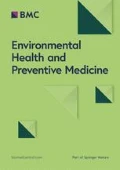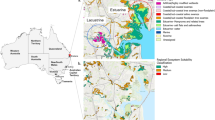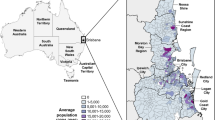Abstract
For the study area of Brisbane City (population 800,000), Australia, 2160 cases of Ross River virus (RRv) infections from the years 1991 to 1996 were geocoded. Their spatial distribution was investigated using census data at the suburb level (162 units). Infection rates have been calculated and adjusted to the age distribution within each suburb. Signed chi-square tests showed that a large number of suburbs has significantly high or low infection rates. Using Principal Component Factor analysis and regression, a relationship was shown between the proportion of wetlands and bushland in a suburb and the infection rate of RRv. Although flight ranges of up to 50 km have been reported for the major vector speciesAedes vigilax (Skuse), this study indicated that RRv infection risk is significantly high relatively close to mosquito habitats. There were significant differences in the infection rate of RRv between years, however the spatial associations did not appear to differ.
Similar content being viewed by others
References
Kitron U, Pener H, Costin C, Orshan L, Greenberg Z, Shalom U. Geographic information system in malaria surveillance: mosquito breeding and imported cases in Israel. Am J Trop Med Hyg 1994; 50: 550–6.
Hugh-Jones, M. Introductory remarks on the application of remote sensing and geographic information systems to epidemiology and disease control. Prev Vet Med 1991; 11: 159–61.
Freier JE. Eastern Equine Encephalitis in Florida: the use of Geographic Information Systems. Paper presented at the 59th annual meeting of the American Mosquito Control Assoc. April 1993.
Mott KE, Nuttall I, Desjeux P, Cattand P. New geographical approaches to control of some parasitic zoonoses. Bull World Health Organ 1995; 73: 247–57.
Kitron U, Michael J, Swanson J, Haramis L. Spatial analysis of the distribution of LaCrosse encephalitis in Illinois, using a geographic information system and local and global spatial statistics. Am J Trop Med Hyg 1997; 57: 469–75.
Arambulo III, PV, Astudillo V. Perspectives on the application of remote sensing and geographic information system to disease control and health management. Prev Vet Med 1991; 11:345–52.
Beck LR, Rodriguez MH, Dister SW, et al. Remote sensing as a landscape epidemiologic tool to identify villages at high risk for malaria transmission. Am J Trop Med Hyg 1994 ; 51: 271–80.
Bogs F, Newell J, Fitzgerald J. Modeling spatial affects of landscape pattern on the spread of fungal disease in simulated agricultural landscapes. Proc.3rd Int.Conf.on Integrating GIS and Environmental Modeling, Nat.Centre for Geographic Information Analysis, Santa Fe (CD-ROM) 1996.
Curran M, Harvey B, Crerar S, et al. Australia’s notifiable diseases status. 1996 annual report of the National Notifiable Diseases Surveillance system. Communicable Disease Intelligence (Australia) 1997; 21: 281–307.
Russell RC. Mosquitoes and mosquito-borne disease in southeastern Australia.Department of Medical Entomology, Westmead Hospital, Westmead, NSW 2145 1993.
Pavlovsky EN. Natural nidality of transmissable diseases. Univ of Illinois Press, Urbana 1966.
Barnes P, Dale PER, Muhar A. Landscape epidemiology, risk and mosquito control, Arb Res Aust 1997; 7: 8–11.
Mottram P, Smith D, Gould D, McGinn D, Sheridan J. Mosquito Prevalence in Selected Suburbs Locating at Different Distance from Salt Marsh Breeding Sites. Paper presented at the Seventh Arbovirus Resarch Symposium, Surfers Paradise, Queensland, Australia 1996.
Marks, EN. An atlas of common Queensland mosquitoes. Queensland Institute of Medical Research, Herston 1982.
Russell R.C. Ross River virus: disease trends and vector ecology in Australia. Bull Soc Vector Ecol 1994; 19: 73–81.
Visvalingam M. The signed chi-square measure for mapping. Cartogr J 1978; 15: 93–8.
Krzanowski, WJ. Principles of Multivariate Analysis, A user’s perspective. Oxford Science Publications, Oxford 1988.
Draper N, Smith H. Applied Linear Regression (2nd Edn) John Wiley, New York 1981.
Weinstein P. An ecological approach to public health intervention: Ross River virus in Australia. Environ Health Perspectives 1997; 105: 364–6.
Author information
Authors and Affiliations
Corresponding author
Rights and permissions
About this article
Cite this article
Muhar, A., Dale, P.E.R., Thalib, L. et al. The spatial distribution of ross river virus infections in Brisbane: Significance of residential location and relationships with vegetation types. Environ Health Prev Med 4, 184–189 (2000). https://doi.org/10.1007/BF02931256
Received:
Accepted:
Issue Date:
DOI: https://doi.org/10.1007/BF02931256




